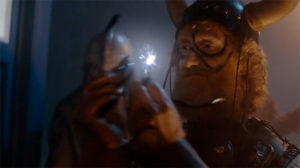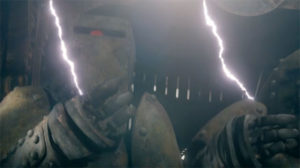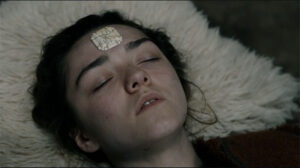12 Great Moments From The Girl Who Died
Mark McCullough picks out 12 faves from the 5th episode of Series 9.
If you asked me to use two words to describe that episode, I think I’d have to go with: absolute rubbish. Then I’d tell you to think what absolute rubbish means, and imagine the opposite, and you’d have this episode! Gotcha! I don’t think it is too much on exaggeration to call The Girl Who Died the best episode of Doctor Who to date. If that’s going too far, then best of Series Nine certainly. That does present me with a problem to decide on just twelve moments, so I have missed anything out that would be the reason. In truth I would love to use the entire episode as one forty-five minute epic moment, but alas here is my list:
12. Rubbish with Names

11. Pre-Titles
 When was the last time the pre-titles scene failed to make the list of twelve moments (likewise with final scenes), has there ever been a case? I guess it confirms the old adage of bookending a narrative with strong scene to leave a good impression. Not that The Girl Who Died needed this as it was fantastic from start to finish. This week we open with a snippet of another adventure, but one which also gives us a warning about the consequences of the Doctor’s actions something which like last week becomes more important as the narrative progresses.
When was the last time the pre-titles scene failed to make the list of twelve moments (likewise with final scenes), has there ever been a case? I guess it confirms the old adage of bookending a narrative with strong scene to leave a good impression. Not that The Girl Who Died needed this as it was fantastic from start to finish. This week we open with a snippet of another adventure, but one which also gives us a warning about the consequences of the Doctor’s actions something which like last week becomes more important as the narrative progresses.
10. False Odin
 Another funny moment, but one that gets included here because, as always, there is more to it. There is a running theme both within Doctor Who (and to a much lesser extent the world around us) that those with superior intellect are given the status of gods, and that things beyond our level of comprehension are dismissed as magic. Of course the narrative would see two beings with technology arrive at once and naturally making the Doctor look a little silly. Also worth noting here was the comments about religion and gods which I am sure did not go down too well with certain aspects of the viewers.
Another funny moment, but one that gets included here because, as always, there is more to it. There is a running theme both within Doctor Who (and to a much lesser extent the world around us) that those with superior intellect are given the status of gods, and that things beyond our level of comprehension are dismissed as magic. Of course the narrative would see two beings with technology arrive at once and naturally making the Doctor look a little silly. Also worth noting here was the comments about religion and gods which I am sure did not go down too well with certain aspects of the viewers.
9. Ashildr Declares War
 Last week (The fact I’m making so many parallels backwards, and there will be more, is a very good sign of how well this series flows) we had a situation where Clara was acting as a pseudo-Doctor with Cass her pseudo-companion. Early this week we see Clara separated from the Doctor and assume his role again on the Mire’s spaceship. This time she has Ashildr acting almost like her companion, and making a mistake typical of a companion’s first adventure. I definitely got Amy in The Beast Below vibes from Ashildr in this scene. You have to wonder if perhaps Mr. Moffat is planning for a future without Clara here. I’ll touch on this again in further down the list. Besides all else I have mentioned about the scene, it was an awesome character moment that allowed Maisie to endear Ashildr to us all.
Last week (The fact I’m making so many parallels backwards, and there will be more, is a very good sign of how well this series flows) we had a situation where Clara was acting as a pseudo-Doctor with Cass her pseudo-companion. Early this week we see Clara separated from the Doctor and assume his role again on the Mire’s spaceship. This time she has Ashildr acting almost like her companion, and making a mistake typical of a companion’s first adventure. I definitely got Amy in The Beast Below vibes from Ashildr in this scene. You have to wonder if perhaps Mr. Moffat is planning for a future without Clara here. I’ll touch on this again in further down the list. Besides all else I have mentioned about the scene, it was an awesome character moment that allowed Maisie to endear Ashildr to us all.
8. Snapping the Sonic Specs
 Controversially I am not fond of the sonic sunglasses. Yeah they were good as a one off, but they should have been kept as that rather than replacing the vastly superior screwdriver. So perhaps it’s not a huge surprise that I was really happy to see them taken from the Doctor’s head and snapped right in front of him. They did actually go on to play an important part in the narrative, but I’m secretly hoping that is the end of them. A screwdriver is more functional and doesn’t sound as silly as the ‘think it and make it happen’ set up we currently have. Each to their own I suppose, but I want the screwdriver back because it isn’t as silly and makes more sense.
Controversially I am not fond of the sonic sunglasses. Yeah they were good as a one off, but they should have been kept as that rather than replacing the vastly superior screwdriver. So perhaps it’s not a huge surprise that I was really happy to see them taken from the Doctor’s head and snapped right in front of him. They did actually go on to play an important part in the narrative, but I’m secretly hoping that is the end of them. A screwdriver is more functional and doesn’t sound as silly as the ‘think it and make it happen’ set up we currently have. Each to their own I suppose, but I want the screwdriver back because it isn’t as silly and makes more sense.
7. The Doctor Decides to Stay
 How fitting is it that what persuaded the Doctor to stay and fight on behalf of the villagers was the cries of a young baby. It’s a theme that has been touched on before in the show, namely in the Beast Below and then again in The Day of the Doctor. I love the fact that the Doctor values innocence above all else, and in essence that is what should typify his character. I also thought it was very smart how the Doctor’s decision to stay was revealed, the silence of the baby’s cry. At a simple level, the Doctor is one who makes things better. Perfect!
How fitting is it that what persuaded the Doctor to stay and fight on behalf of the villagers was the cries of a young baby. It’s a theme that has been touched on before in the show, namely in the Beast Below and then again in The Day of the Doctor. I love the fact that the Doctor values innocence above all else, and in essence that is what should typify his character. I also thought it was very smart how the Doctor’s decision to stay was revealed, the silence of the baby’s cry. At a simple level, the Doctor is one who makes things better. Perfect!
6. Defeating the Mire
 To be honest the Mire were a farcical villain, their leader was a laughable buffoon collecting testosterone from the universe (just a little bit creepy). So the solution to their impending attack had to be equally as silly. Using electric eels to take out ‘one of the deadliest warrior races in the entire galaxy’ (The Daleks would like a word with Monsieurs Moffat et Mathieson) is to put it nicely, outside the boundaries of believability. Yet it works, spectacularly because the narrative is well aware of the fact and is not afraid to poke fun at itself. In contrast to the heavier character moments, it was nice to have a silly villain to keep the episode’s fun factor and not make it too emotionally heavy.
To be honest the Mire were a farcical villain, their leader was a laughable buffoon collecting testosterone from the universe (just a little bit creepy). So the solution to their impending attack had to be equally as silly. Using electric eels to take out ‘one of the deadliest warrior races in the entire galaxy’ (The Daleks would like a word with Monsieurs Moffat et Mathieson) is to put it nicely, outside the boundaries of believability. Yet it works, spectacularly because the narrative is well aware of the fact and is not afraid to poke fun at itself. In contrast to the heavier character moments, it was nice to have a silly villain to keep the episode’s fun factor and not make it too emotionally heavy.
5. Immortality
 Above I mentioned my suspicion that Moffat may have inserted Ashildr as a potential future companion. It certainly would not be out of form given Oswin’s introduction before Amy’s departure. It has also been suspiciously quiet in terms of news regarding the search for Jenna’s replacement. Granted this is pure speculation, but what sealed the deal for me was the Doctor’s discussion on immortality and his companions lack thereof. It raises an interesting preposition in that we know Clara’s days are numbered, so after this conversation it would make sense for the Doctor to choose a next companion who is immortal, to save him future pain. I also loved how the Doctor gave Ashildr a second patch so she could have a companion too and be spared the pain of the person she cares about the most dying. One would have to ask though: why has the Doctor not done the same for Clara? It would make you consider there may be some substance in the theory that Clara is already dead. The Doctor did tell Ashildr that he would see her often enough, but perhaps it’s just wishful thinking on my part to have Maisie as a companion.
Above I mentioned my suspicion that Moffat may have inserted Ashildr as a potential future companion. It certainly would not be out of form given Oswin’s introduction before Amy’s departure. It has also been suspiciously quiet in terms of news regarding the search for Jenna’s replacement. Granted this is pure speculation, but what sealed the deal for me was the Doctor’s discussion on immortality and his companions lack thereof. It raises an interesting preposition in that we know Clara’s days are numbered, so after this conversation it would make sense for the Doctor to choose a next companion who is immortal, to save him future pain. I also loved how the Doctor gave Ashildr a second patch so she could have a companion too and be spared the pain of the person she cares about the most dying. One would have to ask though: why has the Doctor not done the same for Clara? It would make you consider there may be some substance in the theory that Clara is already dead. The Doctor did tell Ashildr that he would see her often enough, but perhaps it’s just wishful thinking on my part to have Maisie as a companion.
4. I’m So Sick of Losing
 I’ll admit it took me a moment to register what the Doctor was talking about here having just won the battle, however the narrative placed Clara in the same boat so that is fine. What I loved about this episode was how bare it stripped the Doctor revealing an emotional side that was somewhat subdued in the previous series. Here we see the impact it has on him every time someone he cares about dies. Contrast his reaction here with the death in Into the Dalek last series where he claimed it was necessary to save the rest of them: cold hearted and ruthless. Now we know the extent of the Doctor veil, it is impossible not to feel immensely sorry for him. Moffat and Mathieson manage to open an empathetic connection to the Doctor like no other writer has managed before.
I’ll admit it took me a moment to register what the Doctor was talking about here having just won the battle, however the narrative placed Clara in the same boat so that is fine. What I loved about this episode was how bare it stripped the Doctor revealing an emotional side that was somewhat subdued in the previous series. Here we see the impact it has on him every time someone he cares about dies. Contrast his reaction here with the death in Into the Dalek last series where he claimed it was necessary to save the rest of them: cold hearted and ruthless. Now we know the extent of the Doctor veil, it is impossible not to feel immensely sorry for him. Moffat and Mathieson manage to open an empathetic connection to the Doctor like no other writer has managed before.
3. The Doctor Resurrects Ashildr

2. I’m the Doctor, and I Save People

1. The Final Scene
What a simplistic, yet visually stunning scene! When you opt for a close up of an actor/actress’ face with the background rotating around them, you naturally run the risk of producing a cringe-worthy scene. This is not the case here however and that is largely due to the effort of the three parties involved in creating what turned out to be a very powerful scene. The main component was Maisie’s undeniable talent conveying a range of emotions through only her body language, second was director Edward Bazalgette who was on form throughout. The final contributor to such a fantastic scene was Murray Gold who has defied expectation and somehow raised him game to an even higher level this year (I would never have thought that possible).









